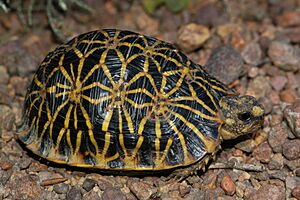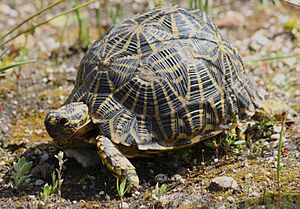Geometric tortoise facts for kids
Quick facts for kids Geometric tortoise |
|
|---|---|
 |
|
 |
|
| Conservation status | |
| Scientific classification | |
| Genus: |
Psammobates
|
| Species: |
geometricus
|
| Synonyms | |
|
|
The geometric tortoise (Psammobates geometricus) is a very special and rare type of tortoise. It is known as a critically endangered species, which means it is at a very high risk of disappearing forever. This small tortoise is one of only three types in its group, called Psammobates. You can only find it in a tiny part of the South-Western Cape of South Africa.
Contents
What Does the Geometric Tortoise Look Like?
This tortoise has a really strong shell, called a carapace. It's black and yellow with cool patterns that look like rays. These patterns help the tortoise hide in its environment. If you look down from above, the shell has shapes that look like geometric symbols, which is how it got its name!
The geometric tortoise is quite small. A fully grown one is only about 13–15 centimetres (5.1–5.9 in) wide. That's about the size of a small dinner plate! It's one of the rarest tortoises on Earth. Scientists think there are only about 2,000 to 3,000 left. But because they blend in so well and don't move around much, it's hard to get an exact count.
While it looks a lot like its relatives in the Psammobates group, you can tell the geometric tortoise apart by the bright yellow star patterns on its shell plates. It also has a small neck plate and a single armpit plate. Unlike some other tortoises, it doesn't have bumps on its backside. The back edges of its shell are only slightly turned up.
Where Do Geometric Tortoises Live?
The geometric tortoise naturally lives only in the very south-western part of the Western Cape Province in South Africa. It used to live in a much larger area, stretching from Piketberg in the north to Gordons Bay in the south, and east into the Breede River valley.
Their special home is called the renosterveld. This area is part of the Fynbos biome, which is a type of plant zone with a Mediterranean climate. This means it has wet winters and dry summers. The renosterveld is a mix of heathlands and shrublands, which are areas with small bushes.
Geometric tortoises need specific things to survive in their habitat. They prefer low, well-drained areas. These spots often have more shrubs and plants that offer good cover, about 50 cm above the ground. The area where they live gets winter rain, usually between 350–600 mm each year.
Sadly, farming and city growth have caused a huge drop in the number of these tortoises. The destruction of the renosterveld has shrunk their home to less than 3% of its original size. Only about 4,000-5,000 hectares are left. Tortoises need food, shelter, places to lay eggs, and space to move around. These are all vital for their survival.
The last group of geometric tortoises in Cape Town died out in a tiny place called Harmony Flats Reserve. People thought the species was extinct in the 1960s. But in 1972, a surviving group was found! Now, they live in three separate areas where they are protected. One group is in the Ceres valley, another in the Tulbagh-Worcester valley, and a third group lives on the coastal lowlands to the southwest.
These colourful tortoises can only live in lowland fynbos and renosterveld plants. This means that mountains, which they cannot cross, easily separate their groups.
What Do Geometric Tortoises Eat?
The geometric tortoise eats mostly leaves, underground bulbs (geophytes), flowers, and young shoots. They get these from many different types of fynbos and renosterveld plants and grasses that grow naturally in their home.
Some of their favourite foods include Crassula ciliata, different Oxalis species, and local geophytes like Cyanella hyacinthoides, Babiana angustifolia, and Lachenalia contaminata. They also enjoy various grasses such as Themeda triandra, Briza maxima, Cynodon dactylon, Ehrharta calycina, Pentaschistis curvifolia, and Eragrostis curvula.
If they don't have all these specific plants, geometric tortoises often don't survive. This is true if they are taken out of their natural home or kept as pets. Their special diet, along with the climate, humidity, and soil, is why they can't live long outside their habitat. This also means they are limited to certain types of fynbos and renosterveld plants in the south-western Cape.
The geometric tortoise eats at least 14 different plant species. This includes many Aspalathus, Oxalis, and Berkheya species found in their specific renosterveld home. Since they live in a winter rainfall area, annual grasses and other small plants are important foods in winter. In summer, when green plants are less common, they rely on perennial grasses, shrubs, and succulents.
Their food plants tend to have more iron and are easier to chew than plants they don't eat. When eating, the tortoise uses a "grab and pull" method. They take small bites, which helps them digest their food more easily.
Geometric Tortoise Behaviour and Life Cycle
Geometric tortoises are said to "aestivate" during the months of June through September. Aestivation is like hibernation, but for hot, dry periods. They do this when their environment isn't normal or if they are kept in captivity.
Not much is known about how they reproduce. When a female is ready to lay eggs, she digs a hole in the ground. Then, she covers it with grass or other plants to keep the eggs safe.
These tortoises usually feed during the cooler parts of the morning and afternoon. They are quite shy. If they notice people watching them, they tend to hide and seek shelter.
Threats and Conservation Efforts
The geometric tortoise is one of the rarest land tortoises in the world. It is listed as critically endangered on the IUCN Red List. This means it faces a very high risk of extinction. Also, it is protected by international law under Appendix I of CITES. This law makes it illegal to trade these tortoises commercially across countries.
South Africa has the most tortoise species in the world, and it's also home to the rarest one. Protecting these special tortoises is a top job for the country's conservation officials. These officials work with nature preserves to help keep the tortoise from becoming extinct.
Their habitat is always in danger. It faces destruction and breaking up into smaller pieces due to frequent fires. Also, there are more predators and an increase in plants that are not native to the region. Their home is now split into only thirty-one small areas, with seven of these being protected reserves. The conservation group in the Western Cape province has made protecting the geometric tortoise one of its highest priorities. The areas where they still live are mostly places that are not good for farming.
CapeNature is one of the provincial nature preserves where these tortoises live. They consider the tortoise a high priority. They constantly watch the tortoise population to see how their conservation efforts are working. CapeNature believes that tracking animal populations helps them know which animals need the most help. It also shows what helps the animals thrive and what harms them. Watching the population is the first step in any effort to save this species. They count the population every year by walking through the preserve and counting the tortoises they see.
Other efforts are also happening to help the species survive. Scientists are studying what the geometric tortoise eats to understand its environmental needs. They are also looking into problems caused by non-native plant species.
Public support for government conservation efforts is often low. Because of this, private conservation efforts have become more common. These private groups help by adding to the limited money the government has for conservation. This is sometimes called "wildlife ranching." It allows large areas of land to be protected without much cost to the government.
Other Information
- Learn more about the geometric tortoise


